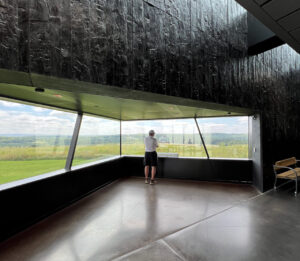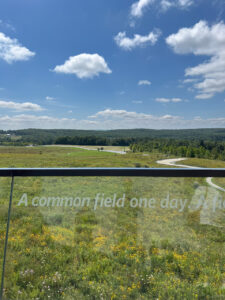
The National Park Service Visitor Center’s viewing window of the 9/11 crash site. Photo by John Griswold
Driving east from Pittsburgh toward Baltimore, intending to stop at Gettysburg, I was surprised to be reminded in the middle of the Pennsylvania countryside of the nearby Flight 93 crash site, now a National Memorial run by the National Park Service.
Hijackers on September 11, 2001, purposely crashed the United Airlines passenger jet 70 miles southeast of Pittsburgh, on a former strip-mine site between Stoystown and Shanksville, after plans to use it as a weapon against a target in Washington, DC—likely the U.S. Capitol—were interrupted by passengers on the plane fighting back. Thirty-seven passengers (including four al-Qaeda terrorists) and seven crewmembers died.
It took half an hour to drive to the memorial from Highway 76, where the Comfort Inn at the exit had placed in their lawn 2,977 little American flags representing the lives lost on 9/11. The smaller state roads leading to the memorial were empty except for a few bikers, and I did not have to watch my rearview mirror for somebody coming up quick behind me. Towns and landscape features are named for tribes, and road markers explain pioneer camps and wars.
I had thought the mountains were done, but there are still 10 percent grades, and the road twists and rises and falls through the hills. Route 30 is the historic Lincoln Highway, now also called Flight 93 Memorial Drive. It is beautiful country, though a group has placed a billboard prominently to compare, for visitors, the deaths of Flight 93 passengers and abortion. There is also a country porn palace and a microbrewery on the way.
But maybe that is part of the point: 9/11 was about disruption of normal people’s everyday lives. One can imagine the shock of local residents that calamity had come down in their fields bordered with sumac and teasle.
It is still another three miles after Route 30, down through the memorial property, to the crash site. The property consists of a sculptural tower with wind chimes, a visitor center’s a short distance away, two walking trails, a Wall of Names, and a sandstone boulder marking the impact site.
The visitor center’s parking lot held so many Corvettes and men wearing Mustang-themed shirts that I thought it simply could not be coincidence and there had to be a car show nearby. A sidewalk to the visitor center is marked with a line indicating the approach of the jet. Since it is not far from there, mere seconds in flight time, to the crash site, one is made conscious of how low the aircraft was at that point, of how little time was left, and of the terror of the people onboard. This day was hot, and biting gnats were out in clouds—gnats in ears eyes and mouth when you opened it to say Jesus these gnats—and visitors were choosing not to walk down the hill to the crash site but to view it from an observation deck past the visitor center.
The wife of a friend was a Senior Vice-President for the company that built the concrete and glass visitor’s center and the memorial site. In fact, she has a connection to all three 9/11 sites, having also run the first major renovation of the Pentagon, and served as a consultant on the dismantling of the Deutsche Bank Building at Ground Zero (one of the buildings that did not collapse but had to be taken down).
She says the Flight 93 Visitor Center is the most emotional of any project she has worked on in her career, and that many of the Park Service personnel stayed with the project from start to finish. Some of the visitor center’s display is also given to Somerset County Coroner Wally Miller, who stayed with the years of follow-up work after the crash and often served as both public face of the effort to know what happened and as liaison, in a very personal way, with the families of those lost. He became known as The People’s Coroner.
“I had to be that public guy for a long time,” said Miller on his retirement in 2021, “and you kind of lose touch with who you really are, and now I finally have the time to rediscover that person with the ability and privilege of having all those years of experience to make yourself better.”
The visitor center holds displays with photos, audio, and text explaining the event, as well as fragments from the crash. The impact disintegrated the aircraft, and the pieces are tiny. The flight recorder was found buried 25 feet under the crash site. Metal fragments were found a mile and a half away, and pieces of paper and nylon up to eight miles away. One of the hijacker’s bank cards was found under a tree, allowing the FBI to begin to connect the events and financial planning of that day. Some of the debris and human remains were reburied onsite.

The view of the crash site from the observation deck. Photo by John Griswold
The abandoned strip mine had been a “blight” even before the crash. The effort to reclaim it as memorial shows there is always hope for better things, even as the sense of layered calamity remains and disturbs. You sense the land’s human use over time but have to remind yourself that the spinning blades of windmills in the distance have nothing to do with airplanes.
An older man wearing a “Born in the USA Corvette” shirt and jeans-shorts was leaving the visitor’s center. He had a standard-issue, OG phone holder on his belt and butch haircut. He held the door for me and seemed to want to say something but did not. He saw another older man in a Tilley hat and shades, leaning on a black concrete wall and facing away from the long vista from the observation deck down to the impact site.
“You okay?” the man in the Corvette shirt offered.
“Yep,” the other man said. It was hard to say he was emotional. “Just a lot to take in.”
